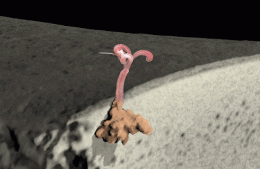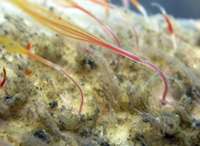Bone-eating 'zombie' worms can no longer hide

Bone-eating 'zombie' worms may be good at keeping out of sight, living off dead whales in the darkness of the sea floor, but scientists have found out how to detect them, even if there’s no trace of their bodies or a few million years have gone by.
Worms from the Osedax genus (group) do not have a mouth or gut. Instead, they use root-like tissue to bore into and eat whale bones that have fallen to the sea floor, hence the ‘zombie’ nickname.
The borings, or canals, that the worms leave behind in the bones have been identified by a team led by marine biologist Nicolas Higgs at the Natural History Museum and the University of Leeds.
Finding out the specific characteristics of Osedax borings and being able to distinguish them from the borings of other animals, means scientists can look for the existence of Osedax in other fossils and find out more about their, and whales', evolutionary history.
The team studied borings in a 3-million-year-old whale bone fossil from the Mediterranean in Italy, which they thought may have been made by Osedax worms. They used the Museum’s micro CT (Computed Tomography) scanner, which can reveal incredible detail and accuracy, in 3D, without damaging a specimen.
They compared the borings with those made by living Osedax worms and other animals such as bivalves and other marine worms.
Higgs explains the research, ‘At first I was sceptical, but the more I investigated the borings the more confident I became that these borings were caused by Osedax, so it was a slow build up of excitement.
'Identifying Osedax traces was one of the main aims of my research project, but finding these small borings is like finding a needle in a haystack so I felt pretty lucky too.’
When unique borings in fossils are identified, they are given what is known as a trace fossil name, similar to how animals are classified and given species and genus names. They are not given the name of the animal that made them because the same animal may make several different traces. Conversely the same trace may be made by several species of animal.
This research means there is now a new trace fossil species called Osspecus tuscia, meaning ‘bone cavern of Tuscany'.

Today, Osedax worms are widespread throughout the world’s oceans. But this trace fossil is the first evidence that Osedax has lived in the Mediterranean.
Another fossil has shown traces of Osedax worms, from the Pacific 30 million years ago.
Because of what we know about how oceans have been connected and disconnected in the past, the team says Osedax is likely to have been widespread.
About 6 million years ago, the Mediterranean dried up and closed off and became very salty with most of the sea life wiped out. It then refilled around 5.3 million years ago, when the Atlantic broke through.
‘Osedax was found after the refilling of the Mediterranean occurred so was probably living in the Atlantic since this is where Osedax would have entered from,’ says Higgs.
‘Our results tell us that Osedax worms were very widespread throughout the world’s oceans in the past and so may have had a significant negative effect on the global fossil record of whales, since they were destroying the bones,' says Higgs.
Wherever there were sunken whale carcases in the past, Osedax worms were probably there too. Some of the whale bones will have been completely degraded before they could be buried and fossilised.
Scientists may now need to take another closer look at the whale fossil record, taking into account the bones ‘hidden’ by the weird bone-eating worms.
The paper Evidence of Osedax worm in Pliocene is published in the journal Historical Biology.
Provided by American Museum of Natural History



















